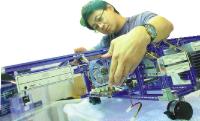Computer
Chip Noise may Betray Code
 The
noise emitted by computer chips could help code breakers decipher
encrypted messages, according to preliminary research carried
out at the Weizmann Institute in Israel. Adi Shamir and Eran
Tromer sampled the high-frequency audio produced by computer
central processing units (CPU) - the highly complicated devices
that perform the majority of calculations inside computers -
in a recording studio.
The
noise emitted by computer chips could help code breakers decipher
encrypted messages, according to preliminary research carried
out at the Weizmann Institute in Israel. Adi Shamir and Eran
Tromer sampled the high-frequency audio produced by computer
central processing units (CPU) - the highly complicated devices
that perform the majority of calculations inside computers -
in a recording studio.
They discovered
that they could distinguish between different cryptographic
keys being processed by the chip, according to the frequency
of the sound emitted. They also found they could determine the
length of a string of characters by measuring the duration of
certain sounds. This is because these correspond to the amount
of time taken to process the key. These details could, in theory,
make it substantially simpler for an assailant to break the
code used to protect valuable data on a computer
"Our
preliminary analysis of acoustic emanations from personal computers
shows them to be a surprisingly rich source of information on
CPU activity," the researchers write on a web page outlining
their work. "This looks like a very exciting finding,"
says Markus Kuhn, at Cambridge University in the UK. "It's
another indication that there are many types of compromising
emanations still waiting to be discovered." Kuhn notes
that others have examined ways of monitoring the power-supply
fluctuations exhibited by chips to remotely gather information
about cryptographic activity.
Peter Honeyman
at the University of Michigan is also impressed by the technique
and says it seems especially promising because it is not disrupted
by additional noise from a computer. The method detects only
high-frequency CPU noise and filters out lower frequency sounds
like the whirr of the fan inside a computer.
Obese people
more likely to die in car crashes
 Heavier
people are more likely to be killed or seriously injured in
car accidents than lighter people, according to new research.
This could mean car designers would have to build in new safety
features to compensate for the extra hazards facing overweight
passengers. In the US, car manufacturers have already had to
redesign air bags so they inflate to lower pressures, making
them less of a danger to smaller women and children. But no
one yet knows what it is that puts overweight passengers at
extra risk.
Heavier
people are more likely to be killed or seriously injured in
car accidents than lighter people, according to new research.
This could mean car designers would have to build in new safety
features to compensate for the extra hazards facing overweight
passengers. In the US, car manufacturers have already had to
redesign air bags so they inflate to lower pressures, making
them less of a danger to smaller women and children. But no
one yet knows what it is that puts overweight passengers at
extra risk.
A study
carried out in Seattle, Washington, looked at more than 26,000
people who had been involved in car crashes, and found that
heavier people were at far more risk. People weighing between
100 and 119 kilograms are almost two-and-a-half times as likely
to die in a crash as people weighing less than 60 kilograms.
And importantly, the same trend held up when the researchers
looked at body mass index (BMI) - a measure that takes height
as well as weight into account. Someone 1.8 metres tall weighing
126 kilograms would have a BMI of 39, but so would a person
1.5 metres tall weighing 88 kilograms. People are said to be
obese if their BMI is 30 or over. The study found that people
with a BMI of 35 to 39 are over twice as likely to die in a
crash compared with people with BMIs of about 20. It is not
just total weight, but obesity itself that's dangerous.
Crash tests
normally use dummies that represent standard-sized males weighing
about 78 kilograms. Recently, smaller crash-test dummies have
also been used to represent children inside crashing cars. But
larger and heavier dummies are not used, the US National Highway
Traffic Safety Administration in Washington DC told New Scientist.
The reasons for the higher injury and death rates are far from
clear. Mock speculates that car interiors might not be suitably
designed for heavy people. Or obese people, with health problems
such as high blood pressure or diabetes, could be finding it
tougher to recover from injury.
Richard
Kent, an expert in impact biomechanics at the University of
Virginia, thinks the new research has established a legitimate
connection between obesity and severe injury or death. Because
the research used BMI data, it has not confused taller (and
therefore heavier than average) people with those who are overweight.
People who are obese might also be at risk because seat belts
do not hold them as securely in a crash. "For example,
a large amount of [fat] tissue between the restraint system
and the bony thorax acts much like a winter coat: it introduces
"slack" into the restraint system and decreases its
performance," Kent says.
Source:
NewScientist.com

 The
noise emitted by computer chips could help code breakers decipher
encrypted messages, according to preliminary research carried
out at the Weizmann Institute in Israel. Adi Shamir and Eran
Tromer sampled the high-frequency audio produced by computer
central processing units (CPU) - the highly complicated devices
that perform the majority of calculations inside computers -
in a recording studio.
The
noise emitted by computer chips could help code breakers decipher
encrypted messages, according to preliminary research carried
out at the Weizmann Institute in Israel. Adi Shamir and Eran
Tromer sampled the high-frequency audio produced by computer
central processing units (CPU) - the highly complicated devices
that perform the majority of calculations inside computers -
in a recording studio.  Heavier
people are more likely to be killed or seriously injured in
car accidents than lighter people, according to new research.
This could mean car designers would have to build in new safety
features to compensate for the extra hazards facing overweight
passengers. In the US, car manufacturers have already had to
redesign air bags so they inflate to lower pressures, making
them less of a danger to smaller women and children. But no
one yet knows what it is that puts overweight passengers at
extra risk.
Heavier
people are more likely to be killed or seriously injured in
car accidents than lighter people, according to new research.
This could mean car designers would have to build in new safety
features to compensate for the extra hazards facing overweight
passengers. In the US, car manufacturers have already had to
redesign air bags so they inflate to lower pressures, making
them less of a danger to smaller women and children. But no
one yet knows what it is that puts overweight passengers at
extra risk.